|

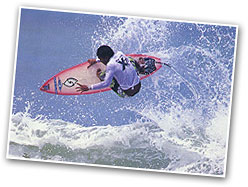 Bali has given a
magical gift to the global surfing community. That gift is surf!
Like a magnet, Bali's surf has attracted the world's best surfers to
ride and discover Indonesia's best-kept secret. Bali has given a
magical gift to the global surfing community. That gift is surf!
Like a magnet, Bali's surf has attracted the world's best surfers to
ride and discover Indonesia's best-kept secret.
Robert Koke, an American who ran a small
hotel somewhere near the present Hard Rock Hotel at Kuta in the
1930's, was the first person to surf in Bali. In the late 1960s
Australian surfers started arriving to surf the Kuta area before
discovering the world class waves of the Bukit Peninsula.
Surf movie producer Albie Falzon
documented the discovery of Uluwatu in his 1972 movie, "Morning of
the Earth". Other movies and other surfers followed and by the mid
1970's, a surf trip to Bali was an annual event for many Australian
surfers.
Today, Bali is the front door for
hardcore surfers setting to explore the many excellent quality waves
throughout the rest of Indonesia. Before they head off to discover
the surf of Java, Sumbawa, Lombok or the Mentawai Islands, they
should never overlook the quality and perfection of Bali's
surf.
 In Bali, the
experienced surfer should start on the Bukit Peninsula. During the
dry season, May to October, the western side of the peninsula
creates some of the world's best waves. Starting at the southern end
is Uluwatu, a peeling lefthander which can hold a heavy swell. Ulu's, as it is affectionately known, has a number of sections:
Temples, The Peak, Race Track and Outside Corner. The next wave
north, Padang-Padang, is one of the best and heaviest lefthanders in
the world and needs a solid swell to start working. Padang is for
experienced surfers only! In Bali, the
experienced surfer should start on the Bukit Peninsula. During the
dry season, May to October, the western side of the peninsula
creates some of the world's best waves. Starting at the southern end
is Uluwatu, a peeling lefthander which can hold a heavy swell. Ulu's, as it is affectionately known, has a number of sections:
Temples, The Peak, Race Track and Outside Corner. The next wave
north, Padang-Padang, is one of the best and heaviest lefthanders in
the world and needs a solid swell to start working. Padang is for
experienced surfers only!
Just across the channel from Padang is a
series of long winding lefthanders appropriately called Impossibles,
which can either be your best friend or your worst enemy. The next
break is Bingin, another lefthander, which provides some of the most
intense small wave tubes you may ever experience - watch out for the
end section as it gets very shallow.
Next is a rare wave on this side if the
Bukit, Dreamland, a right and left peak. Around the corner from
Dreamland is Balangan a fun lefthander, which used to peel along a
beautiful lagoon in a beautiful tropical setting - sadly the area is
no longer as beautiful as it is now a large hotel
development.
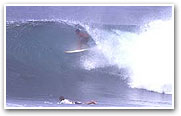 The southern
shore of the Bukit has two waves. Nyang-Nyang, a bowly righthander
and Green Ball a longer right are both located at the bottom of
large cliffs and require a lot of effort to be reached. During the
wet season, November to April, the eastern coast of the Bukit turns
it on with some outstanding (righthanders). Nusa Dua is a big wave
break known to hold well over 5 meter waves: There are three main
sections: Top, Middle and End all producing long bowling rights.
North of Nusa Dua is Sri Lanka, a bowly right, which breaks into a
deep water channel. Across the Benoa Boat Harbor is the resort area
of Sanur, this area has four main reef breaks. Hyatt Reef, Tandjung
Rights, Tandjung Lefts and Sanur Reef. Of these four waves the best
and most popular is Sanur Reef, a world class righthander. The southern
shore of the Bukit has two waves. Nyang-Nyang, a bowly righthander
and Green Ball a longer right are both located at the bottom of
large cliffs and require a lot of effort to be reached. During the
wet season, November to April, the eastern coast of the Bukit turns
it on with some outstanding (righthanders). Nusa Dua is a big wave
break known to hold well over 5 meter waves: There are three main
sections: Top, Middle and End all producing long bowling rights.
North of Nusa Dua is Sri Lanka, a bowly right, which breaks into a
deep water channel. Across the Benoa Boat Harbor is the resort area
of Sanur, this area has four main reef breaks. Hyatt Reef, Tandjung
Rights, Tandjung Lefts and Sanur Reef. Of these four waves the best
and most popular is Sanur Reef, a world class righthander.
Back on the west side of the island,
around the Airport and Kuta areas are a series of reef and beach
breaks. Waves break off either side of the airport runaway: Airport
Rights break on the southern side into Jimbaran Bay, Airport Lefts
breaks on the Kuta side. Both are excellent waves and worth a surf.
North of the runaway is Kuta Reef a long lefthander and the first
reef surfed in Bali.
The Kuta Beach Breaks tend to have their
own character and can get very good; the best sports are Halfway,
Padma and Double Six. This is the area of beach and surf where
tourists, inexperienced with surfing and the ocean, have their first
contact with the surf. Be warned, as this area can be dangerous when
the swells get big. Swim between the red and yellow flags and follow
the instructions from the lifeguards. Experienced surfers should
also exercise care and show respect to the local Balinese
surfers.
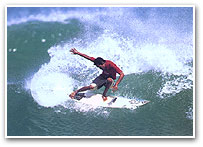 Good surf is not
restricted to the Bukit and Kuta areas. Following the coastline
around the west and eastern sides of the island can be worthwhile,
there are still secret sports to be found. Along the west coast
check out Canggu, about half an hour's drive north of Kuta, a good
right and left rock reef setup. Further north, Balian River Mouth is
a fun left and right break and Medewi, a long winding left-hand
point wave. Good surf is not
restricted to the Bukit and Kuta areas. Following the coastline
around the west and eastern sides of the island can be worthwhile,
there are still secret sports to be found. Along the west coast
check out Canggu, about half an hour's drive north of Kuta, a good
right and left rock reef setup. Further north, Balian River Mouth is
a fun left and right break and Medewi, a long winding left-hand
point wave.
Access to all the breaks via car is easy,
even Uluwatu now has it's own car park right above the break. When
surfing the Nusa Dua and Kuta Reef areas, you can still hire one of
the local boats to take you out to the reef and return you at an
appointed time.
There are two other areas accessible from
Bali worth surfing during the dry season. The first is Nusa
Lembongan Island just east of Bali, here you can surf Lacerations
and Shipwrecks, two fast bowling (righthanders) as well as the less
demanding Playgrounds a left and right.
The second area may well be the best wave
in the world; G-Land or Grajagan located on the southern tip of East
Java. This spiraling, dazzling lefthander has three main sections:
Kongs, Money Trees and the crown jewel of the trilogy, Speedies.
Since 1995 G-Land has hosted the annual Quicksilver Pro, the richest
and most highly respected surf contest in the world. The 1997
Quicksilver Pro will long be remembered as one of the greatest
contests ever when Speedies turned on in all its glory for the
entire contest.
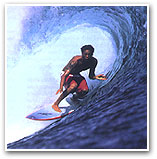 You can get to
Nusa Lembongan by taking a boat from either Sanur or Benoa Harbour
and finding accommodation when you arrive. G-Land is a bit more
difficult and you must book, as the two camps are located inside a
National Park. There are two camps to choose from, the Tiger Camp
and the Jungle Camp. Ask at most surf shops in Kuta and they will
tell you how to contact the camps. You can get to
Nusa Lembongan by taking a boat from either Sanur or Benoa Harbour
and finding accommodation when you arrive. G-Land is a bit more
difficult and you must book, as the two camps are located inside a
National Park. There are two camps to choose from, the Tiger Camp
and the Jungle Camp. Ask at most surf shops in Kuta and they will
tell you how to contact the camps.
Now that you know where to surf, how do
you know what it will be like? Firstly you need to know the tides;
Tubes Bar and most surf shops can provide you with a tide chart for
free, knowing the tides is important when surfing the coral reefs.
Accurate five-day swell forecasts can be picked up from outside the
Quicksilver Board riders Club at Bemo Corner, Kuta and other - surf
shops. Working out the right mixture of conditions is up to you.
Good luck!
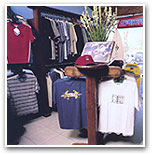 The Kuta area
has the highest concentration of surf shops anywhere in the world.
The newer, larger shops compare more than favorably with the best
surf shops in the USA, Europe, Japan or Australia. All the major
surf brands are represented, Quicksilver, Billabong, Rip Curl,
Spyderbilt, Volcom, Stussy, Rusty and many more. If purchased from
surf shops they are all genuine products but be careful in the
warungs where they are usually copies, which put nothing back into
the Balinese surfing. The genuine product is still a bargain
compared to the Japanese, USA or Australian prices so enjoy your
shopping for a new pair of board shorts or a tee shirt. The Kuta area
has the highest concentration of surf shops anywhere in the world.
The newer, larger shops compare more than favorably with the best
surf shops in the USA, Europe, Japan or Australia. All the major
surf brands are represented, Quicksilver, Billabong, Rip Curl,
Spyderbilt, Volcom, Stussy, Rusty and many more. If purchased from
surf shops they are all genuine products but be careful in the
warungs where they are usually copies, which put nothing back into
the Balinese surfing. The genuine product is still a bargain
compared to the Japanese, USA or Australian prices so enjoy your
shopping for a new pair of board shorts or a tee shirt.
To get the best surfing equipment and
other needs at reasonable prices, go to Dream Land Surf Shop in Kuta
Square. Surfer Girl, as its name implies, caters to the needs of
women and girls. It is sited at Jalan Legian, and offers excellent
buys at very competitive prices.
If you want to party while in Kuta there
are several great bar-cum-restaurants that cater to surfers. Check
out Tubes Bar in Poppies II and All Stars Surf Cafe at Kuta Centre
in Jalan Katika Plaza.
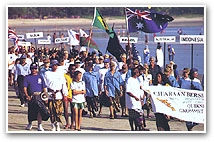 The Bali Surfing
Association runs local contests as well as the Bali International
Grommet Contest and the Billabong Asia Challenge. The local
highlight is the annual Bali Open, which crowns the Island Champion
each December. Balinese surfing legends such as Made Kasim, Wayan
Suwenda, Ketut Menda, Wayan Ganti and Made Switra still surf
regularly. The new generation of surfers spearheaded by Bali's
unofficial International Ambassador, Rizal Tandjung and ably
supported by Ismael Dooley and Made Adi Putra all have international
potential: Tandjung cemented his surfing reputation at the 1996 and
1997 Quicksilver Pro when he scored perfect 10 point waves in each
event against the best surfers in the world. The Bali Surfing
Association runs local contests as well as the Bali International
Grommet Contest and the Billabong Asia Challenge. The local
highlight is the annual Bali Open, which crowns the Island Champion
each December. Balinese surfing legends such as Made Kasim, Wayan
Suwenda, Ketut Menda, Wayan Ganti and Made Switra still surf
regularly. The new generation of surfers spearheaded by Bali's
unofficial International Ambassador, Rizal Tandjung and ably
supported by Ismael Dooley and Made Adi Putra all have international
potential: Tandjung cemented his surfing reputation at the 1996 and
1997 Quicksilver Pro when he scored perfect 10 point waves in each
event against the best surfers in the world.
As surfing has evolved from an
alternative lifestyle into the huge commercial proposition it now
is, Bali has gone along for the ride. It is now possible to arrive
on the island and fully deck yourself out in quality surf gear from
a range of well-known surf-wear companies. One can easily buy or
hire boards of all shapes and sizes, or even take surfing lessons at
the "Cheyne Horan" school of surfing. You may simply like to hang
out in surf restaurants and warungs, which offer menu items such as
"surf-and-turf", Californian hamburgers, and jaffles with good old
Aussie vegemite. Continuous surfing videos, an array of surfing
memorabilia, and life sized fiberglass boards on larger than life
moulded waves (providing the opportunity to capture that "perfect
tube" on camera) are now common features of surfers' establishments.
But be careful if you are renting a board on the beach or taking
surf lessons from the guy you just met at the beach. Surfboards are
not toys and they can hurt you and other people when not used
correctly.
For more information regarding Bali and
Indonesian surfing, check out Indo Surf and Lingo website and see what they can
do for your surf needs. Happy surfing and enjoy your holiday in
Bali. |

